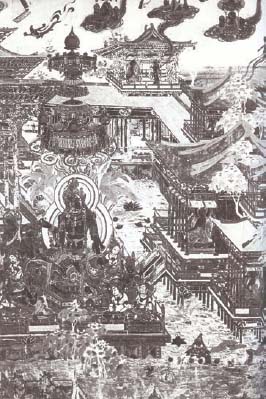The Medieval World, C. 400–1300Chinese Art from the Sui to the Yuan Dynasties, C. 589–1368 |
What is the Paradise of Amitabha painting? |
The Paradise of Amitabha is an eighth-century wall painting within the Dun-huang caves, an important Buddhist site along the Silk Road in northwestern China. In the ninth century, the Tang Emperor Wuzong had ordered Buddhist temples and shrines to be destroyed, but Buddhist art in the Dunhuang caves survived such a fate. In the painting, the large figure seated in the center is Ami-tabha on a raised platform. Lesser deities and bodhisattvas dance around Amitabha in a lavish scene that evokes the splendor of paradise.

The Amitabha Buddha is a central figure in Pure Land Buddhism, and serves as a type of savior or role model. The Paradise of Amitabha wall paintings (a section is illustrated here), located in the Dunhuang Caves in Gansu Provice, China, show the Amitabha Buddha as a large, central figure.
